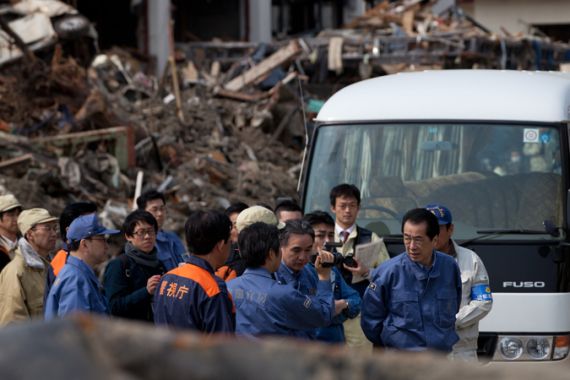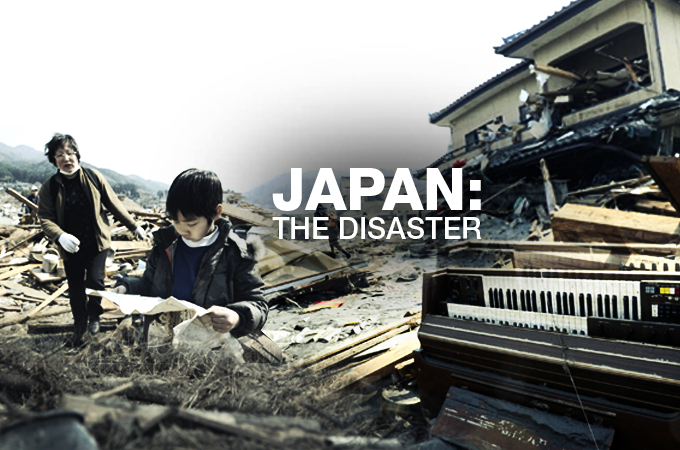Japan PM visits tsunami-hit areas
Naoto Kan’s visit criticised for coming late as his government faces increasing pressure to prevent a nuclear meltdown.

| Kan has come under criticism by some who say he did not take a leading role in dealing with the disaster [Al Jazeera] |
Japan’s prime minister Naoto Kan has visited tsunami-ravaged areas of the country, promising support “to the end” for victims of the disaster.
Kan, who flew into the city of Rikuzentakata in the Iwate prefecture on a military helicopter from the capital, Tokyo on Saturday, was also due to stop in nearby Fukushima prefecture, in a show of support for emergency crews risking their lives to prevent meltdown at a nuclear plant.
Keep reading
list of 4 itemsCould shipping containers be the answer to Ghana’s housing crisis?
Thousands protest against over-tourism in Spain’s Canary Islands
Holding Up the Sky: Saving the Indigenous Yanomami tribe in Brazil’s Amazon
In Rikuzentakata, Kan met with the mayor, volunteer emergency workers and evacuees living in makeshift shelters.
His visit comes as residents of evacuated areas near the stricken Fukushima nuclear plant were warned that they may not be able to return to their homes for months as Japan’s nuclear crisis stretched into a third week.
“A person who had a house along the coastline asked ‘where could I build a house in the future?'” Kan told reporters after visiting a shelter.
“I said the government will do its best to support you until the end,” he said.
City in ruins
In Rikuzentakata, a community with a population of 24,466 prior to the disaster, at least 1,049 people are confirmed dead and 1,253 are still missing as rescue work continues.
Large parts of the city lie in ruins, with only the shells of a few concrete buildings left standing.
The town saw its picturesque forest and golden beaches destroyed by the deadly 9.0-magnitude earthquake and subsequent tsunami, with thousands of local residents still living in evacuation centres.
The prime minister is also scheduled to visit “J-village” in Fukushima, the base for hundreds of emergency crew members who have been working at the nuclear plant battered by the tsunami.
The plant has been leaking radiation, triggering worldwide concern, as workers continue tense stop-and-go efforts aimed at shutting it down. The environmental impact is also worsening, with high levels of radioactive materials found in air, soil, groundwater and seawater.
Al Jazeera’s Marga Ortigas, reporting from Yamagata in the north, said that many have criticised the prime minister for visiting the areas now.
“Many say that he has come too late, as well as focusing too much on the Fukushima plant, and not on the growing humanitarian crisis in the country,” she said.
On Friday, Yukio Edano, the country’s chief cabinet secretary, said that the neighbourhoods near the plant will remain empty “for the long term”.
Though he did not set a timetable, he said residents would not be able to return permanently “in a matter of days or weeks. It will be longer than that”.
Mounting pressure
Nuclear workers are struggling to regain control of the damaged plant, 240km north of the capital, Tokyo, with radiation in water in an underground tunnel more than 10,000 times above normal levels found in reactors, the plant operator told the Kyodo news agency earlier this week.
 |
Highly radioactive water spilled into the ocean from a newly discovered crack in a maintenance pit on the edge of the Fukushima complex, said Hidehiko Nishiyama, Nuclear and Industrial Safety Agency spokesman.
The crack was apparently caused by the quake and may have been leaking since then, said spokesman Osamu Yokokura of Tokyo Electric Power Co., which runs the plant.
Radiation quickly disperses in both air and water, and experts have said that it would be quickly diluted by the vast Pacific Ocean, where even large amounts have little effect. TEPCO is trying to pour concrete to seal the
20-cm-long crack, spokesman Takashi Kurita said.
Radioactive iodine-131 at concentrations higher than the legal limit was first detected in waters off the plant more than a week ago.
Government intervention
Officials also announced that Japan will take control of the embattled energy company in the face of mounting public concerns over the crisis and a potential compensation bill that Bank of America-Merrill Lynch estimated could run to $130bn.
“If the stake goes over 50 per cent, it will be nationalised. But that’s not what we are considering,” an unnamed government official told Mainichi newspaper.
The injection of public funds “will allow the government to have a certain level of management involvement”, said the paper’s source.
The company, the largest electric power corporation in Asia, has been criticised over its release of information since the crisis began. But reports of the bail-out were not enough to stop its share price sliding 10 per cent in early trading.
In other sectors, Japan’s business confidence was reported by the Bank of Japan’s Tankan survey as being bolstered by improvements in production and overseas demand over the past several months. But analysts expect confidence to fall sharply as companies tally the economic costs of the disaster.